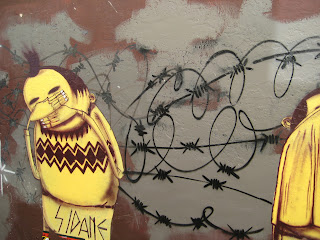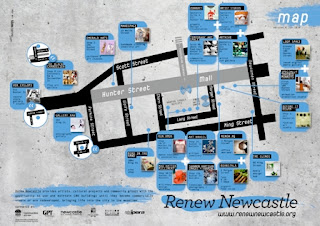No formal classes over our 2 week uni break, so I thought I would explore Relational Aesthetics, a topic introduced to us in Week 4. In one of our most engaging lectures of the semester, artist Lucas Ihlein gave us a broad overview of Relational Aesthetics and Art. Lucas’s charisma, humour and obvious passion for the subject all helped to draw a definitive picture of the meaning of Relational Aesthetics, how it can be interpreted and understood, and how it is relevant today.
 |
| Lucas Ihlein (2004, MCA) |
Relational Aesthetics is an approach to fine art practice which emerged in the 1990s, first observed and definitively explored by French theorist, curator and critic Nicolas Bourriaud. Relational Aesthetics was a new definition of art – encompassing the artist, world and audience as integral to the artwork instead of judging the artwork as a singular and isolated object. Relational Aesthetics is an approach to art based in human relations and social context, artworks are interactive and connecting, in which encounters between artist, audience and engagement in the artwork can change or define the artwork itself.
Relational Aesthetics refers to artwork that is open-ended, interactive and resistant to closure. Relational Art takes place in time and space and creates interactive communicative experiences and intersubjective encounters in which meaning is elaborated collectively.
– Legier Biederman (2006, Biederman)
While speaking with us, Lucas touched on a host of interesting examples of artworks, performances and projects in order to visually and verbally communicate the meaning and intentions of Relational Aesthetics, ranging from his own projects and work with NUCA (Network of Un-Collectable Artists) to local and international artists, historically and currently practicing.
 |
| NUCA collectable and swapable artist cards (2004, Lowe) |
One of the examples I found particularly interested was San Francisco based artist Mark Horowitz, who uses humour in performance art to translate his ideas. A great example of this is one Lucas mentioned – Horowitz’s ‘Errand Feasibility Study’. Horowitz describes this project as an attempt to solve some of the common problems encountered when going about everyday activities, such as ‘loneliness and alienation, boredom, impatience, anxiety, frustration, lethargy, hunger, flatulence, humming a Neil Diamond song, encountering stinky children, head bumps, and thoughtlessness.’ (2010, Horowitz)
This was attempted in two ways, which Horowitz termed Phase I and Phase II – one: Horowitz accompanied strangers on their errands, offering advice and helping out, two: he repeated the exercise, but rode a pack mule. Horowitz documented the hilarious outcomes of his study, attracting media attention as he performed tasks such leading his mule ‘Hail’ into Wal-Mart to return a purchase.
 |
| Marc and Hail running an errand (2010, Horowitz) |
Horowitz’s reknowned blog, ‘I need to stop soon’, is a treasure trove of Horowitz’s thoughts, past and current projects, ideas and oddities. Another more recent project documented on the blog (and linked flickr site) is Horowitz’s ‘Recessionator’, a scheme to solve America’s financial crisis. Horowitz, dressed in a white plastic onesy, bounces on a trampoline while his assistant sprays him with paint. He then jumps off, landing on the canvas to create artworks with his body. Horowitz then gave the paintings to banks free of charge ‘so they could sell them and use the money to bail themselves out of the fiscal crisis, thereby taking the burden off the taxpayers.’ (2010, Horowitz)
 |
| Horowitz creates original artworks using the Recessionator (2010, Horowitz) |
I see this project as a hybridization between conceptual artist Yves Klein’s ‘blue’ series of work, impressions of female figures transferred to the canvas via the body, and Napoleon Dynamite.
 |
| Yves Klein's artworks, created by painting the female body then laying the body on canvas, leaving a blue impression (2008, Wunderlich) |
 |
| Uber-geek Napoleon, from cult classic film 'Napoleon Dynamite'. Not only does Horowitz echo his bizarre, off-beat antics, but even bears a resemblence to him...(2010, Funny Mormans) |
In other words, a hilarious play on the value and appreciation of art. Perhaps Horowitz’s artworks will actually be able to bail out America once he is dead…
Currently, Horowitz is preparing for a new project set to begin on the 1st of November. The project, titled ‘The Advice of Strangers’ is Horowitz’s idea of figuring out what to do with his life – based on the decisions of others. The public will be able to vote in real-time on-line, on every decision Marc makes for one month, from boring to serious to intimate.
The Truman Show, Marc Horowitz style. Cast your vote here.
Work like Marc Horowitz's that can be loosely clarified as Relational Art is really inspiring - I think performance is something that really has an impact, something we could utilise in the Foley St event. The idea of Relational Art is a strong undercurrent in our Grassroots concept, which is based around the Green Performer getting out into the streets and talking to people, making them aware of our concept and what they can do to help. We will also set up a blog for people to follow over the weeks leading up to Open House - Marc Horowitz's blog illustrates just how effective this method of communication is - even if you weren't there to experience the event, you can still live it vicariously.
 |
| My illustration of the Grassroots Green Performer |
It is great to build/make/create installations for events like this, but with an interactive, performative element it can become something much more - an experience as well as a visual presentation.
REFERENCES
2002, Bourriaud, N., Relational Aesthetics, Les presses du réel, France
2006, Biederman, L., A Global Art World: Relational Aesthetics, New Media Arts and Biennialization, Duke University, viewed on 11/9/2010, http://lbiederm.bol.ucla.edu/Site/
2004, MCA: Museum of Contemporary Art, Artist Talk: In the Balance, MCA, viewed on 11/9/2010, http://www.mca.com.au/default.asp?page_id=14&content_id=7015
16/6/2004, Lowe, K., NUCA (Network of Un-Collectable Artists) Card Set Swap Meet – Sydney, Chaos Generation Weblog, viewed on 11/9/2010, http://www.chaosgeneration.com/2004_06_01_archives.htm
2010, Horowitz, M., I Need to Stop Soon, WordPress and Semiologic CMS, viewed on 12/9/2010, http://www.ineedtostopsoon.com/
20/10/2010, Horowitz, M., marchorowitz’s photostream, Flickr, viewed on 12/9/2010, http://www.flickr.com/photos/marchorowitz/
23/1/2008, Wunderlich, Forum: drawing tutorials, link to some helpful tutorials, The Carving Path, IP. Board, viewed on 12/9/2010, http://www.thecarvingpath.net/forum/index.php?showtopic=1282
2010, Funny Mormans, Napoleon Dynamite, WordPress, viewed on 12/9/2010, http://funnymormons.com/2010/09/napoleon-dynamite/
2010, Horowitz, M., The Advice of Strangers, Creativetime, viewed on 12/9/2010, http://www.theadviceofstrangers.com/


























